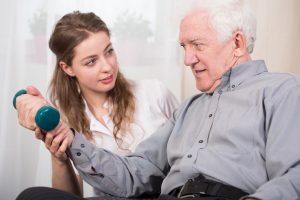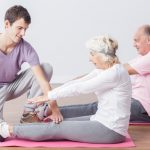 Stroke rehabilitation often involves exercises to improve post-stroke recovery. This is because many motor skills can become affected after a stroke depending on the area of the brain is affected. For example, patients may need to redevelop their ability to walk or even use their hands.
Stroke rehabilitation often involves exercises to improve post-stroke recovery. This is because many motor skills can become affected after a stroke depending on the area of the brain is affected. For example, patients may need to redevelop their ability to walk or even use their hands.
Stroke rehabilitation is often conducted alongside a physiotherapist who will work closely with you to improve mobility. They may also provide you with exercises to complete at home in order to boost your abilities and ensure you become stronger, quicker.
Advertisement
Rehabilitation exercises are often repetitive in nature. This is because in order for the brain to rewire itself, these activities must be repeated over and over to teach the brain what to do. This process is known as neuroplasticity.
The type of rehabilitation you perform is based on a few different things, including stroke severity, the part of the brain that was affected, the impact of the stroke on your mind and body, your general health, and how long you are able to work on your recovery.
In stroke rehabilitation patients, walking on an underwater treadmill produces better exercise performance
Research has found that in stroke rehabilitation patients, walking on an underwater treadmill produces better exercise performance. Researcher Bo Ryun Kim explained, “Aquatic treadmill exercise may be a useful option for early intensive aerobic exercise after subacute stroke, as it may both improve their aerobic capacity and maximize functional recovery.”
The study included 21 patients recovering from stroke with some walking ability and impaired leg movement on one side.
The patients underwent a conventional treadmill test and an aquatic treadmill one where the patient is submerged in water up to their chest. Gradual increases to speed and incline were completed until the patient could no longer continue. Exercise capacity was compared between the two tests.
Higher measurements were seen during the aquatic treadmill test in both maximal oxygen consumption (VO2max), reflecting heart and lung function during exercise, and metabolic equivalents (METs), reflecting the use of energy. Heart rates were not that different between the two tests.
Even though the results showed harder performance during the aquatic treadmill test, patients did not feel as if they were working harder, which shows the aquatic treadmill exercise is a viable way to improve stroke recovery faster without the added strain.
The authors explained, “The fact that the aquatic treadmill efficiently provides aerobic exercise without requiring full weight bearing means that it may be highly suitable for rehabilitation after stroke.”
Although additional research is needed so far the aquatic treadmill test looks promising in promoting more effective stroke rehabilitation.
Arm and hand exercises for stroke rehab patients
 Many people don’t feel that stretching is an exercise, but it most definitely is, and it can help improve arms and hands during stroke rehabilitation. Stretching helps relieve muscle spasticity that can occur post-stroke.
Many people don’t feel that stretching is an exercise, but it most definitely is, and it can help improve arms and hands during stroke rehabilitation. Stretching helps relieve muscle spasticity that can occur post-stroke.
With stretching as a foundation, range-of-motion exercises are also useful for the arms and hands.
Some basic movements you can complete are moving the arm to its full range of motion several times a day. This should feel like a slight pull or strain sensation, but comfortable enough that you aren’t causing injury.
When holding a stretch, you should feel slight discomfort, but no numbness, tingling, or serious pain. Stretches should be held for a minimum of 20 seconds, and you can gradually extend this time period as you progress in your rehabilitation.
Another type of exercise for arm and hand rehabilitation is known as functional exercise. This involves repeating the same task with your hand and arm over and over. Some specialists will recommend constraint-induced movement therapy (CIMT) to accompany this exercise.
CIMT involves restricting the use of your unaffected arm and only using your affected arm to perform tasks. This helps your brain relearn how to use that arm along with building strength in it again as well.
Some examples of CIMT include opening and closing a door several times, holding a grocery bag in the affected hand and carrying it around the house, pulling laundry out with the affected arm, moving light objects from one area to another, squeezing toothpaste, or turning a light switch on and off.
Strength training is also an option. One study of 517 stroke patients found that using small weights and resistance bands to strengthen arm and hand muscles did not increase spasticity or pain, making it safe for stroke rehab patients to perform for rebuilding muscle and strength.
Advertisement
If you haven’t exercised in a while, it’s important that you embark on physical activity carefully and make sure you have approval from your doctor. To begin, you will want to work with a physical therapist who can guide you with proper form and techniques in order to improve mobility and function, and decrease pain and other uncomfortable sensations.
The key is to not become frustrated. Stroke rehabilitation can take some time, and as long as you work at it, you can gain back many functions that were temporarily lost after the stroke occurred. Staying positive and putting in the necessary work can have you feeling yourself in no time.
Sources:
http://wolterskluwer.com/company/newsroom/news/2016/08/aquatic-treadmill-walking-may-increase-exercise-capacity-after-stroke.html
https://www.sciencedaily.com/releases/2016/08/160823103436.htm
http://www.webmd.com/stroke/features/arm-and-hand-exercises-for-stroke-rehab
http://www.webmd.com/stroke/features/arm-and-hand-exercises-for-stroke-rehab?page=2
http://www.webmd.com/stroke/features/arm-and-hand-exercises-for-stroke-rehab?page=3
